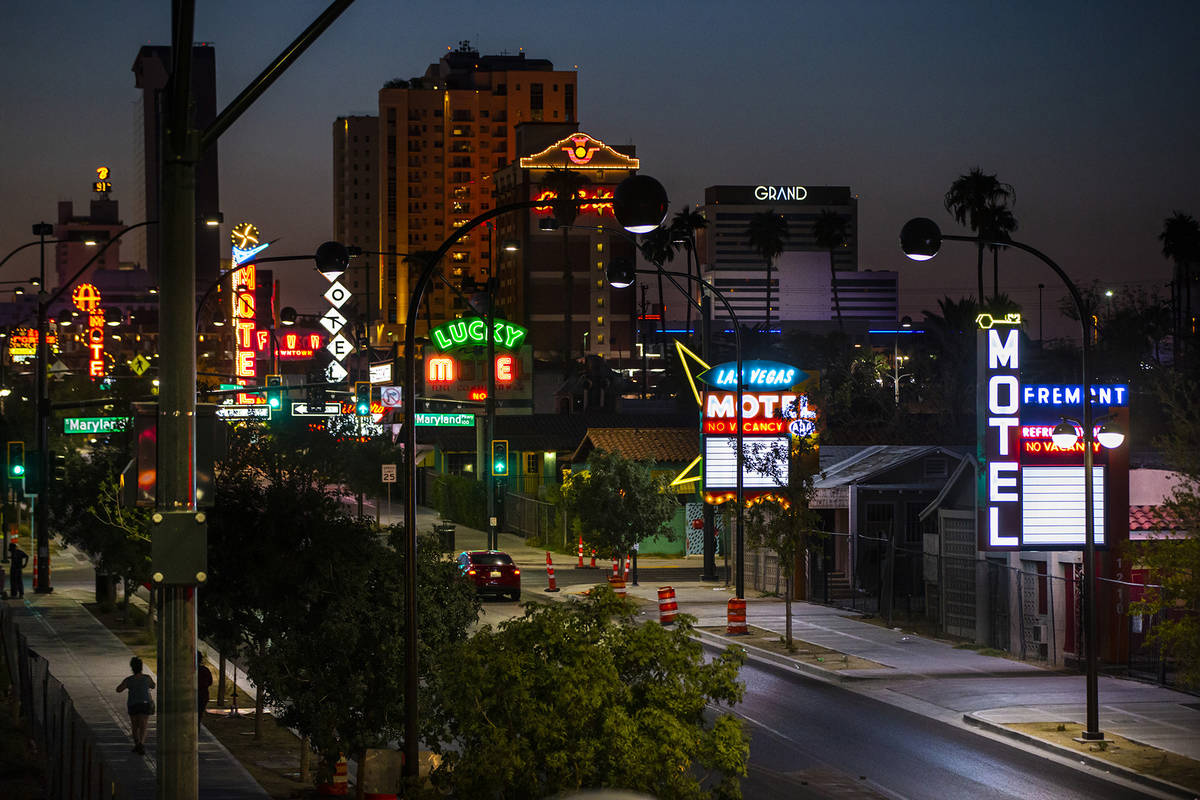Neon signs downtown get a facelift

He likes to say that if Las Vegas had a signature, it would be written in neon.
But what happens when said penmanship fades?
Enter Brad Jerbic.
“This is real neon. This is all handblown glass tubes,” the former Las Vegas city attorney observes as he strolls down Fremont Street, eyeing vintage signage. “You don’t see it on the Strip anymore.”
On a recent hot-as-a-light-bulb afternoon, Jerbic leads a tour of his latest endeavor: the restoration of neon signs downtown.
Though he retired as Las Vegas City Attorney last year after nearly three decades on the job, Jerbic now volunteers his time to complete Project Enchilada, a multiphase refurbishment of a wide swath of the area, which he began to conceptualize in the fall of 2017.
“This project is 12 square miles,” he explains. “It goes all the way from I-15 to Eastern (Avenue), all the way from U.S. Highway 95 to Charleston (Boulevard). Doing the original proposal to the city, I said, ‘All we do is a project. Instead of doing one thing, we have all the right ingredients, let’s fold them all together. Let’s do the whole enchilada.’ ”
And with that, a big idea had an equally sizable name.
Downtown rebound
Project Enchilada will feature a number of components, from rebuilding the facades of various motels to landscaping additions to bringing back old-school streetlights.
Working in unison with the Downtown Project, Jerbic is currently focusing on the restoration of neon signs, aided by a $750,000 grant from the Las Vegas Centennial Commission, which focuses on preserving and celebrating the history of Las Vegas.
Seven signs will be redone in total.
Presently, there are three left to paint and two to be rebuilt from scratch.
The emphasis here is on authenticity. To this end, Jerbic and crew are working with, among others, Civic Visions, an East Coast company consisting of a pair of Harvard professors who are ensuring that the design and color of the signs approximate their original incarnations.
“They’re really into midcentury modern architecture,” Jerbic explains. “They’ve come out and scraped every one of these buildings to get right down to the original color. They scraped every one of the signs down to the original color. After that, we matched them, and then provided the paint to Downtown Project, which is painting them.”
The hues are eye-popping, oranges, blues and greens.
“The colors are as funky as all hell,” Jerbic observes, speaking with the enthusiasm of a lawyer making a closing argument. “In the ’40s and ’50s, the automobile industry was beginning to really take off as the national highway system was being built. The colors of the signs and the buildings are the colors of the cars coming out of Detroit in the ’50s, almost exactly.”
Signs of the times
It’s all a labor of love for Jerbic, who’s been walking these streets for decades: His father owned a jewelry shop near Fourth and Fremont when he was a child.
“My dad worked seven days a week sometimes, and if I wanted to see him, I had to come downtown on the weekend,” he recalls. “So I just polished jewelry and cleaned showcases and stuff like that, and walked around Fremont Street.”
As the tour continues, Jerbic walks past “the llama lot,” a parking lot on Fremont and Ninth adorned with paintings of the creature. He plans on brightening the area with still more signs.
“The idea is to literally line this street with neon signs from Fremont Street, from motels that fell on the ground that don’t stand anymore,” Jerbic explains. “We’ve got the Clark Inn, we’ve got the Paradise, we’ve got a bunch of others, getting the funding for them. They’re going to line all of this, so you don’t hit a dead spot anywhere in this block.”
Jerbic is no fan of “dead spots,” which in this context are barren or unkempt portions of downtown.
“I used to tell people that walking down Fremont Street is like looking at a hockey player’s smile: There are so many missing teeth that you hit these dead zones,” he says. “And when you hit a dead zone, you don’t want to go any further.”
The goal of Project Enchilada, then, is to provide the connective tissue among various spots downtown, to unite the past with the present for a high-watt future.
“I love downtown,” Jerbic muses at the end of our journey. “We’re kind of the opposite of the Strip: Don’t blow it up. No matter what it takes, keep it. It’s the last that we have.”